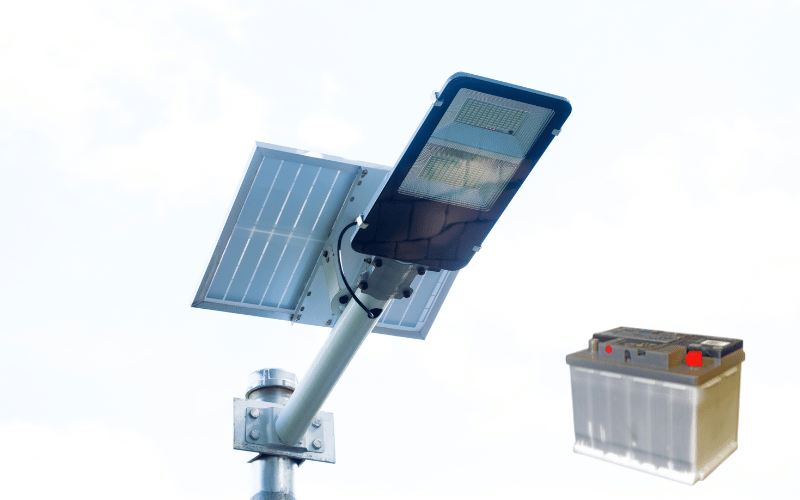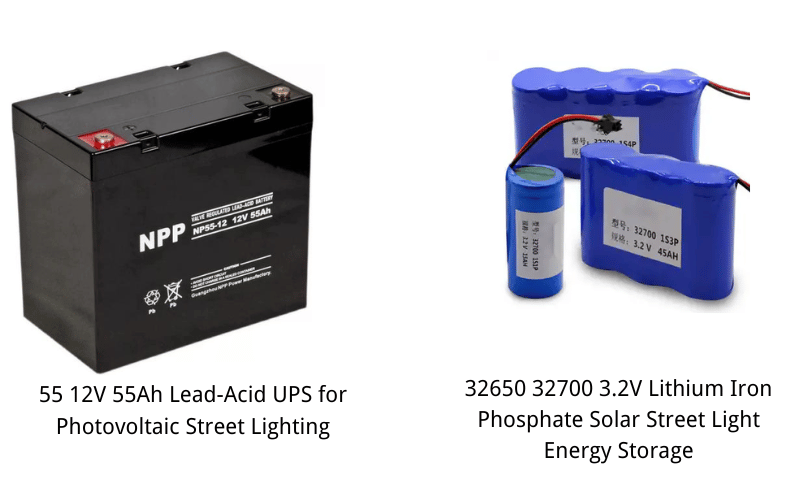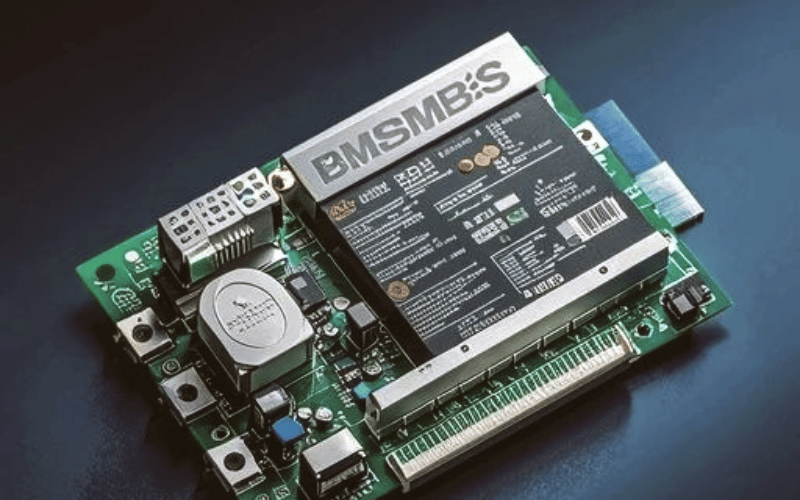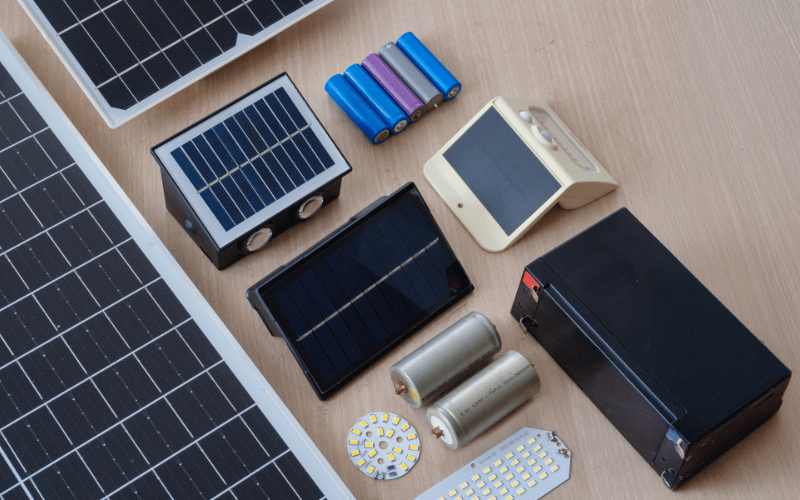Solar street lights are transforming the way we illuminate our communities, offering a sustainable and energy-efficient alternative to traditional lighting. As cities and towns increasingly adopt these solutions, the demand for reliable performance grows. At the heart of every solar street light lies its battery—a critical component that ensures consistent operation, even during cloudy days or long nights.
A well-chosen battery can make or break the effectiveness of a solar street light. It stores the energy collected during the day and powers the light at night, making it the backbone of the system. Without a dependable battery, even the most advanced solar panels and LED lights fall short of their potential. This is why understanding the types of batteries, their maintenance needs, and proper sizing is essential for anyone involved in solar lighting projects.
In this guide, I aim to simplify the complexities of solar street light batteries. Drawing from years of experience in outdoor solar lighting, I’ll walk you through the key factors to consider when selecting a battery. Whether you’re a homeowner, a project manager, or simply curious about solar technology, this article will equip you with practical tips to ensure your solar street lights shine brightly and reliably for years to come.

Table of Contents
ToggleUnderstanding Solar Street Light Batteries
Solar street light batteries are the unsung heroes of sustainable lighting systems. While solar panels and LED lights often steal the spotlight, it’s the battery that quietly works behind the scenes to ensure everything runs smoothly. Let’s dive into the critical role batteries play and the key metrics you need to understand to make informed decisions.
The Role of Batteries in Solar Systems
Think of the battery as the heart of your solar street light system. It doesn’t just store energy—it ensures the system’s lifeblood flows consistently, even when the sun takes a day off. During the day, solar panels collect energy from sunlight, but without a battery, that energy would go to waste as soon as the sun sets. Here’s how batteries keep the system alive:
-
Storing Energy from Solar Panels During the Day
The battery acts as a reservoir, capturing the energy generated by solar panels. This stored energy becomes the power source for the system when sunlight is no longer available. -
Powering LED Lights Consistently Overnight
A reliable battery ensures that your LED lights shine brightly throughout the night, regardless of how long the darkness lasts. It bridges the gap between energy generation and consumption. -
Ensuring System Stability in Varying Weather Conditions
Weather can be unpredictable, but a well-sized battery provides stability. It compensates for cloudy days or shorter daylight hours, ensuring uninterrupted performance.
Without a dependable battery, even the most advanced solar panels and LEDs would falter. This is why understanding battery metrics is crucial for optimizing your solar street light system.
Key Battery Metrics Made Simple
Navigating battery specifications can feel overwhelming, but breaking them down into digestible pieces makes it easier to grasp their importance. Here are the key metrics you should focus on:
-
Capacity (Ah): How It Affects Runtime
Capacity, measured in ampere-hours (Ah), determines how much energy a battery can store. A higher capacity means longer runtime for your solar street lights. For instance, a 100Ah battery can power a 10A load for 10 hours. When sizing your battery, consider the energy demands of your system and the duration of nighttime operation. -
Voltage (V): Standard Voltages for Solar Systems
Voltage is the force that drives current through your system. Most solar street light systems operate on standard voltages like 12V, 24V, or 48V. Matching the battery voltage with your system’s requirements ensures compatibility and efficiency. -
Depth of Discharge (DoD): Its Impact on Battery Life
DoD refers to the percentage of a battery’s capacity that is used before recharging. For example, a 50% DoD means half the battery’s capacity is utilized. Batteries with a higher DoD tolerance, like lithium-ion batteries, last longer because they can handle deeper discharges without degrading quickly. -
Cycle Life: Why It Matters for Long-Term Performance
Cycle life indicates how many charge and discharge cycles a battery can endure before its capacity significantly diminishes. A battery with a cycle life of 2,000 cycles will last longer than one with 500 cycles, making it a critical factor for long-term cost-effectiveness.
Understanding these metrics empowers you to choose the right battery for your solar street light system. By focusing on capacity, voltage, DoD, and cycle life, you can ensure your system operates efficiently and reliably, even in challenging conditions.
Types of Solar Street Light Batteries
Choosing the right battery for your solar street light system is like selecting the perfect partner—it needs to complement your system’s needs while offering reliability and longevity. Batteries come in various types, each with its own strengths and weaknesses. Let’s explore the most common options and how they stack up against each other.
Lead Acid Batteries
Lead acid batteries have been around for over a century, and they remain a popular choice for solar applications due to their affordability and proven track record. However, not all lead acid batteries are created equal. Here’s a closer look at the three main types:
-
Flooded Lead Acid Batteries
These are the traditional workhorses of the battery world. They require regular maintenance, including topping off with distilled water and ensuring proper ventilation to prevent gas buildup. While they’re cost-effective, their bulky size and high maintenance needs make them less ideal for modern solar street light systems. -
Absorbent Glass Mat (AGM) Batteries
AGM batteries are a step up from flooded batteries. They’re sealed, maintenance-free, and more compact. Their ability to handle higher discharge rates makes them suitable for solar applications, but they tend to have a shorter lifespan compared to other options. -
Gel Batteries
Gel batteries use a silica-based electrolyte, which makes them highly resistant to temperature fluctuations and deep discharges. They’re also maintenance-free and have a longer lifespan than AGM batteries. However, their higher cost can be a drawback for budget-conscious projects.
Pros of Lead Acid Batteries:
- Affordable upfront cost.
- Widely available and easy to source.
- Suitable for low-budget or short-term projects.
Cons of Lead Acid Batteries:
- Bulky and heavy, making installation more challenging.
- Require regular maintenance (flooded types).
- Shorter lifespan and lower energy density compared to lithium batteries.
Lithium-Ion Batteries
Lithium-ion batteries have revolutionized the solar street light industry, offering unmatched performance and efficiency. Among the various lithium chemistries, Lithium Iron Phosphate (LiFePO4) stands out as the preferred choice for solar applications.
-
Why LiFePO4 is the Preferred Choice
LiFePO4 batteries are known for their exceptional safety, long lifespan, and high energy density. They can handle thousands of charge-discharge cycles, making them a cost-effective option in the long run. Additionally, their lightweight and compact design simplifies installation and reduces the overall system footprint. -
Comparison with Other Lithium Chemistries
While other lithium chemistries like Nickel Manganese Cobalt (NMC) and Lithium Cobalt Oxide (LCO) are common in consumer electronics, they fall short in solar applications. NMC batteries, for instance, offer higher energy density but have a shorter lifespan and are less stable under extreme conditions. LCO batteries, on the other hand, are not designed for deep cycling, making them unsuitable for solar street lights.
Pros of Lithium-Ion Batteries:
- Long lifespan (up to 10 years or more).
- High energy density and compact size.
- Maintenance-free and highly efficient.
Cons of Lithium-Ion Batteries:
- Higher upfront cost compared to lead acid batteries.
- Requires a Battery Management System (BMS) for optimal performance and safety.

Quick Comparison Table
Here’s a side-by-side comparison to help you weigh the options:
| Feature | Lead Acid Batteries | Lithium-Ion Batteries (LiFePO4) |
|---|---|---|
| Cost | Low upfront cost | Higher upfront cost |
| Lifespan | 3-5 years | 8-12 years |
| Maintenance | Regular (flooded types) | Maintenance-free |
| Energy Density | Low | High |
| Weight | Heavy | Lightweight |
| Temperature Tolerance | Moderate | Excellent |
| Cycle Life | 500-1,000 cycles | 2,000-5,000 cycles |
When selecting a battery, consider the specific needs of your solar street light system, including budget, maintenance capabilities, and desired lifespan. A well-informed choice ensures your system operates efficiently and reliably for years to come.
Choosing the Right Battery for Your Solar Street Light
Selecting the right battery for your solar street light system is not just about picking the most popular option—it’s about finding the perfect match for your specific needs. A well-chosen battery ensures your system operates efficiently, reliably, and cost-effectively. Let’s break down the key factors to consider and how to size your battery correctly.
Factors to Consider
When evaluating batteries, it’s essential to look beyond the price tag. Each system has unique requirements, and understanding these factors will help you make an informed decision.
-
Climate: How Temperature Affects Battery Performance
Batteries are sensitive to temperature, and their performance can vary significantly in extreme conditions. For instance, lead acid batteries tend to lose capacity in cold climates, while lithium-ion batteries, particularly LiFePO4, perform well across a wide temperature range. If your solar street lights are installed in areas with harsh winters or scorching summers, prioritize a battery with excellent thermal stability. -
Load Requirements: Matching Battery Capacity to LED Wattage and Operating Hours
The battery must be capable of powering your LED lights throughout the night. To calculate this, multiply the wattage of your LED light by the number of operating hours. For example, a 30W LED running for 12 hours requires 360Wh of energy. Ensure the battery’s capacity can meet this demand while accounting for depth of discharge (DoD) to avoid over-draining. -
Autonomy Days: Ensuring Sufficient Storage for Cloudy Days
Autonomy refers to the number of days the battery can power the system without sunlight. For areas prone to cloudy weather, aim for at least 2-3 days of autonomy. This ensures your lights remain operational even during extended periods of low solar generation. -
Total Cost of Ownership (TCO): Balancing Upfront Cost with Lifespan and Maintenance
While lead acid batteries may have a lower upfront cost, their shorter lifespan and higher maintenance requirements can increase long-term expenses. Lithium-ion batteries, though more expensive initially, often prove more cost-effective over time due to their durability and minimal maintenance needs. Evaluate the TCO to determine the most economical choice for your project.
Battery Sizing Made Easy
Sizing your battery correctly is crucial for ensuring optimal performance and longevity. Follow these steps to calculate the required capacity:
-
Determine Daily Energy Consumption (Wh)
Calculate the total energy your system consumes in a day. For example, if your LED light is 30W and operates for 12 hours, the daily energy consumption is:
30W x 12h = 360Wh -
Account for Autonomy Days
Multiply the daily energy consumption by the desired number of autonomy days. For 3 days of autonomy:
360Wh x 3 = 1,080Wh -
Adjust for Depth of Discharge (DoD)
To prevent over-draining, consider the battery’s DoD. For a lead acid battery with a 50% DoD:
1,080Wh ÷ 0.5 = 2,160Wh
For a lithium-ion battery with an 80% DoD:
1,080Wh ÷ 0.8 = 1,350Wh -
Convert to Ampere-Hours (Ah)
Divide the adjusted energy requirement by the system voltage to find the required capacity in Ah. For a 12V system:
2,160Wh ÷ 12V = 180Ah(lead acid)
1,350Wh ÷ 12V = 112.5Ah(lithium-ion) -
Consider System Efficiency and Charge Controller Compatibility
Factor in system losses due to inefficiencies in the charge controller and wiring. Add a 10-20% buffer to your calculations to ensure the battery can handle real-world conditions. For example, if your calculated capacity is 180Ah, aim for a battery with at least 200Ah.
By carefully considering these factors and following the sizing steps, you can select a battery that not only meets your system’s needs but also delivers reliable performance for years to come.
Maintenance and Extending Battery Lifespan
A well-maintained battery is the cornerstone of a reliable solar street light system. While modern batteries are designed for durability, neglecting proper care can significantly shorten their lifespan. By following best practices for installation, routine maintenance, and issue prevention, you can ensure your batteries perform optimally for years.
Best Practices for Installation
The foundation of a long-lasting battery begins with proper installation. A poorly installed battery is more prone to damage, inefficiency, and safety risks. Here’s how to set your system up for success:
-
Proper Ventilation and Weather Protection
Batteries need to breathe—especially lead acid types that release gases during operation. Install them in a well-ventilated enclosure to prevent gas buildup and overheating. At the same time, ensure the enclosure provides adequate protection against rain, snow, and direct sunlight. For outdoor installations, weatherproof battery boxes with UV-resistant materials are a must. -
Safe Wiring and Connection Techniques
Secure and clean connections are critical for efficient energy transfer. Use appropriately sized cables to handle the current without overheating, and ensure all connections are tight to minimize resistance. Apply dielectric grease to terminals to prevent corrosion, and always follow the manufacturer’s guidelines for wiring configurations.
Routine Maintenance Tips
Even the most advanced batteries benefit from regular checkups. Routine maintenance not only extends battery life but also helps you catch potential issues before they escalate.
-
Monitoring Voltage and Charge Levels
Regularly check the battery’s voltage and state of charge (SoC) to ensure it’s operating within the recommended range. Overcharging or undercharging can degrade the battery over time. Many systems include a charge controller with built-in monitoring features—use these tools to stay informed. -
Cleaning Terminals and Preventing Corrosion
Corrosion on battery terminals can disrupt energy flow and reduce efficiency. Inspect the terminals periodically and clean them with a mixture of baking soda and water if corrosion is present. After cleaning, apply a thin layer of petroleum jelly or terminal protectant spray to prevent future buildup. -
Specific Care for Flooded Batteries
Flooded lead acid batteries require more attention than their sealed counterparts. Check the electrolyte levels monthly and top off with distilled water as needed. Avoid overfilling, as this can lead to spillage and damage. Additionally, ensure the battery is fully charged regularly to prevent sulphation.
Avoiding Common Battery Issues
Understanding and preventing common battery problems can save you from costly replacements and downtime. Here are some pitfalls to watch out for:
-
Deep Discharge Damage and How to Prevent It
Deep discharges—where the battery is drained beyond its recommended depth of discharge (DoD)—can cause irreversible damage. To avoid this, size your battery correctly for the system’s energy demands and ensure the charge controller is set to cut off power before the battery reaches critical levels. -
Sulphation in Lead Acid Batteries: Causes and Solutions
Sulphation occurs when lead sulfate crystals form on the battery plates, reducing capacity and efficiency. This often happens when a battery remains undercharged for extended periods. To combat sulphation, ensure the battery is fully charged regularly and consider using a desulfator device if the issue persists. -
Thermal Runaway in Lithium Batteries: Risks and Safeguards
Thermal runaway—a chain reaction where the battery overheats uncontrollably—is a rare but serious risk in lithium-ion batteries. It’s typically caused by overcharging, physical damage, or manufacturing defects. To mitigate this risk, always use a Battery Management System (BMS) to monitor and regulate temperature, voltage, and current. Additionally, avoid exposing the battery to extreme heat or physical stress.
By adhering to these maintenance practices and addressing potential issues proactively, you can maximize the lifespan and performance of your solar street light batteries. A little care goes a long way in ensuring your system remains a shining example of sustainable lighting.
Battery Management Systems (BMS): The Hidden Hero
When it comes to lithium batteries, the Battery Management System (BMS) is the unsung hero working tirelessly behind the scenes. Think of it as the brain of your battery, ensuring every cell operates in harmony while protecting the system from potential risks. Without a reliable BMS, even the most advanced lithium battery can falter. Let’s explore why a BMS is indispensable and what features to look for in a good one.

Why BMS Matters for Lithium Batteries
Lithium batteries are powerful and efficient, but they require precise management to perform at their best. A BMS ensures the battery operates safely and efficiently by monitoring, balancing, and protecting its cells. Here’s how it works:
-
Monitoring and Balancing Cells for Optimal Performance
Lithium batteries are made up of multiple cells, each with its own voltage and capacity. Over time, these cells can become imbalanced, leading to inefficiencies and reduced lifespan. A BMS continuously monitors the voltage of each cell and redistributes energy to keep them balanced. This ensures the entire battery operates at peak performance. -
Preventing Overcharging, Deep Discharging, and Overheating
Overcharging can cause lithium batteries to overheat, while deep discharging can permanently damage the cells. A BMS acts as a safeguard, cutting off power when the battery reaches its maximum or minimum voltage limits. It also monitors temperature to prevent overheating, which can lead to thermal runaway—a serious safety hazard.
By managing these critical aspects, a BMS not only extends the battery’s lifespan but also ensures the safety and reliability of your solar street light system.
Key Features of a Good BMS
Not all Battery Management Systems are created equal. A high-quality BMS comes equipped with advanced features that enhance both performance and safety. Here’s what to look for:
-
Cell Voltage Monitoring and Balancing
A good BMS keeps a close eye on the voltage of each individual cell, ensuring they remain within safe operating limits. It also actively balances the cells by redistributing energy, preventing imbalances that can degrade the battery over time. This feature is especially crucial for lithium iron phosphate (LiFePO4) batteries, which rely on precise voltage management. -
State of Charge (SOC) Estimation
Knowing how much energy is left in your battery is essential for efficient operation. A BMS estimates the State of Charge (SOC) by analyzing voltage, current, and temperature data. This information helps you plan energy usage and ensures the battery isn’t overworked or underutilized. -
Communication with the Solar System for Seamless Operation
The best BMS systems integrate seamlessly with your solar street light system, providing real-time data to the charge controller and other components. This communication ensures the entire system operates in sync, optimizing energy usage and preventing issues before they arise. Look for a BMS with communication protocols like CAN bus or RS485 for enhanced compatibility.
A well-designed BMS is more than just a protective measure—it’s an essential component that unlocks the full potential of your lithium battery. By choosing a battery with a robust BMS, you’re investing in the long-term performance, safety, and reliability of your solar street light system.
Quick Tips for Maximizing Battery Performance
Maximizing the performance of your solar street light batteries starts with making informed choices and maintaining vigilance against subpar or counterfeit products. A high-quality battery is the backbone of a reliable system, and knowing what to look for can save you from costly mistakes. Here’s a practical checklist to guide you through the process.
A Checklist for Choosing High-Quality Batteries
Selecting the right battery isn’t just about picking the one with the highest capacity or longest lifespan—it’s about ensuring it meets the specific demands of your solar street light system. Use this checklist to evaluate your options:
-
Match the Battery to Your System’s Requirements
Ensure the battery’s voltage and capacity align with your system’s specifications. For example, a 12V system requires a 12V battery, and the capacity (Ah) should be sufficient to meet your energy demands, including autonomy days. -
Prioritize Proven Chemistries
For solar street lights, lithium iron phosphate (LiFePO4) batteries are often the best choice due to their long lifespan, high energy density, and excellent thermal stability. If you’re considering lead acid batteries, opt for AGM or gel types over flooded ones for lower maintenance and better performance. -
Look for a Robust Battery Management System (BMS)
For lithium batteries, a high-quality BMS is non-negotiable. It ensures safe operation by monitoring cell voltage, balancing cells, and preventing overcharging or deep discharging. -
Evaluate the Manufacturer’s Reputation
Choose batteries from reputable manufacturers with a track record of quality and reliability. Research customer reviews, case studies, and industry certifications to verify their credibility.
How to Spot and Avoid Low-Quality or Counterfeit Batteries
The market is flooded with batteries that promise the world but fail to deliver. Spotting low-quality or counterfeit products requires a keen eye and a bit of skepticism. Here’s how to protect yourself:
-
Beware of Unrealistic Claims
If a battery’s specifications seem too good to be true—such as an unusually high capacity at a suspiciously low price—it’s likely a red flag. Always cross-check claims with industry standards and reviews. -
Inspect the Build Quality
A high-quality battery will have a solid, well-finished casing with no visible defects. Check for clear, professional labeling that includes the manufacturer’s name, model number, and technical specifications. -
Demand Transparency
Reputable manufacturers provide detailed datasheets and test reports for their batteries. If a seller is unwilling or unable to provide this information, it’s best to walk away. -
Verify the Seller’s Credentials
Purchase batteries only from authorized distributors or directly from the manufacturer. Avoid unknown online sellers or marketplaces with limited buyer protection.
Certifications to Look For
Certifications are your assurance that a battery meets safety and performance standards. Here are the key certifications to check for:
-
MSDS (Material Safety Data Sheet)
This document provides detailed information about the battery’s chemical composition, handling precautions, and safety measures. It’s a must-have for ensuring safe transportation and use. -
UN38.3 Certification
This certification is required for lithium batteries to be transported safely by air, sea, or land. It confirms the battery has passed rigorous tests for altitude simulation, vibration, thermal shock, and more. -
IEC 62133
This international standard ensures the safety of rechargeable batteries, particularly lithium-ion and nickel-based chemistries. It’s a critical certification for batteries used in solar applications. -
RoHS (Restriction of Hazardous Substances)
This certification ensures the battery complies with environmental standards by limiting the use of hazardous materials like lead, mercury, and cadmium.
By following this checklist, staying vigilant against low-quality products, and prioritizing certified batteries, you can ensure your solar street light system operates efficiently and reliably. A little due diligence upfront can save you from headaches and expenses down the road.
End-of-Life and Responsible Disposal
Every battery has a lifespan, and knowing when and how to retire it responsibly is just as important as choosing the right one. Ignoring the signs of a failing battery can compromise your solar street light system, while improper disposal can harm the environment. Let’s explore how to identify when a battery has reached the end of its life and the steps to dispose of it safely and sustainably.
Signs Your Battery Needs Replacement
Batteries don’t fail overnight—they give you warning signs. Recognizing these early can save you from unexpected system downtime and ensure a smooth transition to a new battery.
-
Reduced Runtime and Inconsistent Performance
If your solar street light no longer stays illuminated for the expected duration or the brightness fluctuates, it’s a clear sign the battery is losing its capacity. For example, a battery that once powered a 30W LED for 12 hours may now struggle to last 6 hours. This decline in runtime indicates the battery’s ability to hold a charge has diminished. -
Physical Signs Like Swelling or Leakage
Inspect your battery regularly for visible damage. Swelling, bulging, or leakage are red flags that the battery is no longer safe to use. These issues often result from overcharging, overheating, or internal chemical reactions gone awry. If you notice any of these signs, replace the battery immediately to avoid further damage to your system or potential safety hazards.
Safe Disposal and Recycling
Disposing of batteries responsibly is not just an ethical obligation—it’s a legal requirement in many regions. Batteries contain hazardous materials that can harm the environment if not handled properly. Here’s how to ensure your old batteries are disposed of safely and sustainably:
-
Environmental Risks of Improper Disposal
Batteries, especially lead acid and lithium types, contain toxic substances like lead, cadmium, and lithium salts. When disposed of in landfills, these materials can leach into the soil and water, causing long-term environmental damage. Burning batteries is equally harmful, as it releases toxic fumes into the air. Proper disposal prevents these risks and ensures valuable materials are recovered for reuse. -
How to Recycle Lead Acid and Lithium Batteries Responsibly
- Lead Acid Batteries: These are among the most recyclable batteries, with up to 99% of their components being reusable. Take your old lead acid batteries to a certified recycling facility or return them to the manufacturer, as many offer take-back programs. The lead and plastic casings are typically melted down and repurposed, while the acid is neutralized and safely disposed of.
- Lithium Batteries: Recycling lithium batteries is more complex but equally important. Look for specialized e-waste recycling centers that handle lithium batteries. These facilities extract valuable materials like cobalt, nickel, and lithium for reuse in new batteries. Before recycling, ensure the battery is fully discharged and pack it in a non-conductive material to prevent short circuits during transport.
By recognizing the signs of a failing battery and committing to responsible disposal, you not only protect your solar street light system but also contribute to a healthier planet. Batteries may reach the end of their life, but their materials can live on through recycling—turning waste into a resource for the future.
Frequently Asked Questions
Q: How long do solar street light batteries last?
A: The lifespan of a solar street light battery depends on its type and usage. Lead acid batteries, such as AGM or Gel, typically last 3-5 years with proper maintenance. Lithium-ion batteries, especially LiFePO4, can last 8-12 years due to their higher cycle life and better resistance to deep discharges. Regular monitoring and avoiding overcharging or deep discharging can help extend the battery’s life.
Q: What’s the difference between AGM and Gel batteries?
A: AGM (Absorbent Glass Mat) and Gel batteries are both sealed lead acid types, but they differ in design and performance. AGM batteries use a fiberglass mat to hold the electrolyte, making them better for high-discharge applications and faster charging. Gel batteries, on the other hand, use a silica-based gel electrolyte, which makes them more resistant to temperature fluctuations and deep discharges. AGM batteries are ideal for systems with high energy demands, while Gel batteries work well in extreme climates or for longer autonomy needs.
Q: Why is LiFePO4 better for solar street lights?
A: LiFePO4 (Lithium Iron Phosphate) batteries outperform other chemistries in solar street light applications due to their long lifespan, high energy density, and excellent thermal stability. They can handle thousands of charge-discharge cycles without significant capacity loss, making them cost-effective over time. Additionally, LiFePO4 batteries are lightweight, require no maintenance, and operate safely in a wide range of temperatures, making them a reliable choice for outdoor systems.
Q: How do I calculate the right battery size for my system?
A: To calculate the correct battery size, start by determining your system’s daily energy consumption. Multiply the wattage of your LED light by the number of operating hours (e.g., 30W x 12h = 360Wh). Next, account for autonomy days by multiplying the daily consumption by the desired number of backup days (e.g., 360Wh x 3 days = 1,080Wh). Adjust for the battery’s depth of discharge (DoD) by dividing the total energy by the DoD percentage (e.g., 1,080Wh ÷ 0.8 = 1,350Wh for a lithium battery). Finally, divide by the system voltage to find the required capacity in ampere-hours (e.g., 1,350Wh ÷ 12V = 112.5Ah).
Q: Can extreme temperatures damage my battery?
A: Yes, extreme temperatures can harm your battery’s performance and lifespan. High temperatures can accelerate chemical reactions, leading to overheating or thermal runaway in lithium batteries. Cold temperatures can reduce the capacity of lead acid batteries and slow down the chemical processes in lithium batteries. To protect your battery, install it in a well-ventilated, weatherproof enclosure and choose a battery type suited for your climate. LiFePO4 batteries, for example, perform well in a wide temperature range, making them ideal for extreme conditions.
Conclusion
Choosing the right battery is crucial for the success of your solar street light system. Understanding the differences between battery types, such as lead acid and lithium-ion, helps you select the best option for your needs. Proper sizing ensures your system runs efficiently, while regular maintenance extends the battery’s lifespan and prevents avoidable issues. Invest in a high-quality battery to achieve long-term savings and reliable performance. Make informed decisions and take the time to evaluate your options carefully—your solar street light project deserves nothing less than the best.


